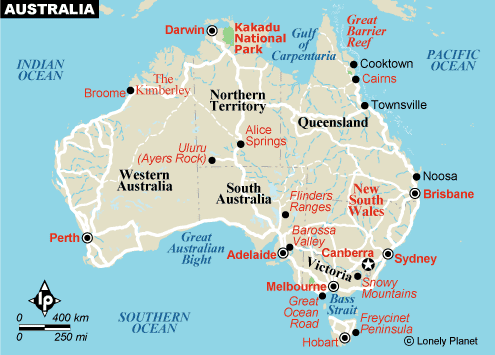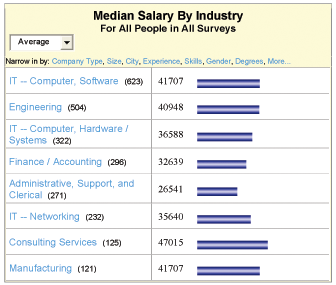|
..:: INTRODUCTION ::.. ..:: GEOGRAPHY ::.. ..:: POPULATION ::.. ..:: GOVERNMENT ::.. ..:: ECONOMY ::..

Introduction
Australia at a Glance
Thinking "outside the box" and contributing original ideas have long been encouraged in Australia because of its highly innovative and dynamic society. These characteristics have helped make Australia an early adopter of technology and have contributed toward its growing reputation as a source for IT services. Although Australia has emerged as a technologically viable country, we believe that there is a unique opportunity for Australia to position itself as a very influential force in global information networks, thus propelling them to greater wealth and prosperity . [0.0]
The main objective of this project is to use the "Readiness for the Networked World" framework [0.1] , to measure Australia's network readiness. Readiness is the degree to which a community is prepared to participate in the Networked World. It is gauged by assessing a community's relative advancement in the areas that are most critical for ICT adoption and the most important applications of ICTs [0.1] .
This project will analyze aspects of Australia's network access, their Learning system from a technological perspective, their society, economy, policies and offshore outsourcing to determine the state of Australia's readiness for the networked world. In conclusion, an assessment of Australia's readiness for the each category and specific recommendations for improvements will be made.
Brief History
Long before Australia became a sovereign state, Aboriginal settlers arrived on the continent from Southeast Asia, about 40,000 years before the first Europeans began exploration in the 17th century. No formal claims were made until 1770, when Capt. James Cook took possession in the name of Great Britain. Six colonies were created in the late 18th and 19th centuries; they federated and became the Commonwealth of Australia in 1901. The new country was able to take advantage of its natural resources in order to rapidly develop its agricultural and manufacturing industries and to make a major contribution to the British effort in World Wars I and II. Australia's official language is English, by common usage rather than law [0.2] .Australian English does not differ significantly from other forms of English, although some colloquial and slang expressions are unique. Australia's national day, Australia Day, on 26 January and it marks the date in 1788 when Captain Arthur Phillip, of the British Royal Navy, commanding a fleet of 11 ships, sailed into Port Jackson (Sydney Cove). Phillip formally took possession of the eastern part of the continent for England and established a settlement, now Australia's largest city, Sydney [0.3]
back
Geography
Australia is the world's smallest continent but sixth-largest country; its land mass of nearly 7.7 million km square is the flattest and (after Antarctica) driest of continents, yet it has extremes of climate and topography. There are rainforests and vast plains in the north, snowfields in the south east, desert in the centre and fertile croplands in the east, south and south west. About one third of the country lies in the tropics. Australia has a coastline of 36,735km [0.4] . Isolation of the Australian island-continent for 55 million years created a sanctuary for the flora and fauna. Marsupials were saved from competition with more highly developed mammals. Birds unique to Australia also survived, and distinctive trees and plants developed. Australia's best-known animals are the kangaroo, koala, platypus and spiny anteater. Of more than 700 bird species listed in Australia, 400 - including the large, flightless emu - are found nowhere else. Australia has 20 000 species of plants [0.5] .
back
Population
Australia has a population of 20,275,700 people (July 2004 est.) with a population growth rate of about 0.9% [0.6] . It is one of the world's most urbanized countries, with about 70 per cent of the population living in the 10 largest cities. Most of the population is concentrated along the eastern seaboard and the south-eastern corner of the continent.
Four out of 10 Australians are migrants or the first-generation children of migrants, half of them from non-English speaking backgrounds. In 1991-92, East Asia contributed 41 per cent of settler arrivals [0.7]
Aboriginal and Torres Strait Islander people totaled 265 378 at the last census, nearly 1.5 per cent of the population. Two thirds of the indigenous people live in towns and cities. Many others live in rural and remote areas, and some still have a broadly traditional way of life.
back
Government
Executive Branch
The executive branch is made up of the chief of state, head of government and cabinet members.
The chief of state is a position held by the Queen of Australia ELIZABETH II (since 6 February 1952), She is represented by the Governor General, Maj. Gen. (Ret.) Michael JEFFREY (since 11 August 2003)
The head of government is Prime Minister John Winston HOWARD (since 11 March 1996); Deputy Prime Minister John ANDERSON (since 20 July 1999)
The parliament nominates and selects cabinet members from among its members and a list of candidates to serve as government ministers; from this list, the governor general swears in the final selections for the Cabinet
There are no election for the chief of state position; the monarch is hereditary; the governor general is appointed by the monarch on the recommendation of the prime minister; following legislative elections, the leader of the majority party or leader of a majority coalition is sworn in as prime minister by the governor general. [0.8]
Legislative Branch
The legislative branch is made up of the senate and House of Representatives. The bicameral Federal Parliament consists of the Senate (76 seats - 12 from each of the six states and two from each of the two mainland territories; one-half of the members elected every three years by popular vote to serve six-year terms) and the House of Representatives (150 seats - this is up from 148 seats in 2001 election; members elected by popular vote on the basis of preferential representation to serve three-year terms; no state can have fewer than five representatives) [0.8]
Judicial Branch
High Court (the chief justice and six other justices are appointed by the governor general) [0.8]
back
Economy
• Currency: Australian dollar
• Currency code is AUD
• Currency Exchange rates: Australian dollars per US dollar - 1.54 (2003), 1.84 (2002), 1.93 (2001), 1.72 (2000), 1.55 (1999) [0.9]
• Gross Domestic Product
• Purchasing power parity - $570.3 billion (2003 EST.)
• GDP real growth rate 2.8% (2003 EST.)
• GDP per capita -purchasing power parity - $28,900 (2003 EST.)
• GDP composition per sector : agriculture: 3%, industry: 25% services: 72% (2003 EST.)
• Inflation rate: 2.7% (2003 EST.)
• Unemployment rate 6.1%
• Budget: revenues: $86.8 billion
expenditures: $84.1 billion, including capital expenditures of $NA (FY00/01 EST.) [0.9]
• Industries
• Mining, industrial and transportation equipment, food processing, chemicals, steel.
• Industrial product growth rate is 1.1% (2003 EST.)
• Exports: $68.67 billion (2003 EST.)
• Export commodities: coal, gold, meat, wool, alumina, iron ore, wheat, machinery and transport equipment
• Export partners: Japan 18.5%, US 9.6%, South Korea 8.3%, China 6.9%, New Zealand 6.5%, UK 4.7%, Singapore 4.1%, Taiwan 4% (2002)
• Imports: $82.91 billion (2003 est.)
• Import Commodities: machinery and transport equipment, computers and office machines, telecommunication equipment and parts; crude oil and petroleum products
• Import Partners: US 18.3%, Japan 12.3%, China 10.1%, Germany 5.7%, UK 4.6% (2002) [0.9]
Workforce
Australia is made up of a highly skilled, creative and innovative workforce . It has a pool of experienced scientists, business analysts, process and software quality experts, consultants, project managers, program managers, technology architects and developers of applications, software and packages. On the flip side, there is a lack of mobility in the workforce. Experienced senior IT professionals with strong family ties in Australia are less willing to travel for long periods of time. This reluctance restricts the opportunity to leverage the strengths of Australian's experienced, highly skilled workforce. Demand for information technology professionals remains strong and in Australia there are skills shortages in some IT occupations (systems analysts, multimedia developers, systems administrators, programmers, systems designers, and computer engineers)[1.0]. The labor force by occupation is broken as shown: services 73%, industry 22%, and agriculture 5% (1997 EST.). [1.1]
Salary
Australia has a lower salary structure than many other advanced economies, such as the United States, the United Kingdom, the European Union and Japan. Although the global economic slowdown during 2001 has prompted a significant decline in starting salaries, IT professionals are still commanding top end salaries. The median graduate salary for computer science graduates in Australia is A$40 000.

[1.1.1]
State of the Economy
Australia has a prosperous Western-style capitalist economy, with a per capita GDP on par with the four dominant West European economies. Rising output in the domestic economy has been offsetting the global slump, and business and consumer confidence remains robust. Australia's emphasis on reforms is another key factor behind the economy's strength. The impact of drought, weak foreign demand, and strong import demand pushed the trade deficit up to $14 billion in 2003 from $5 billion in 2002.
back |
|